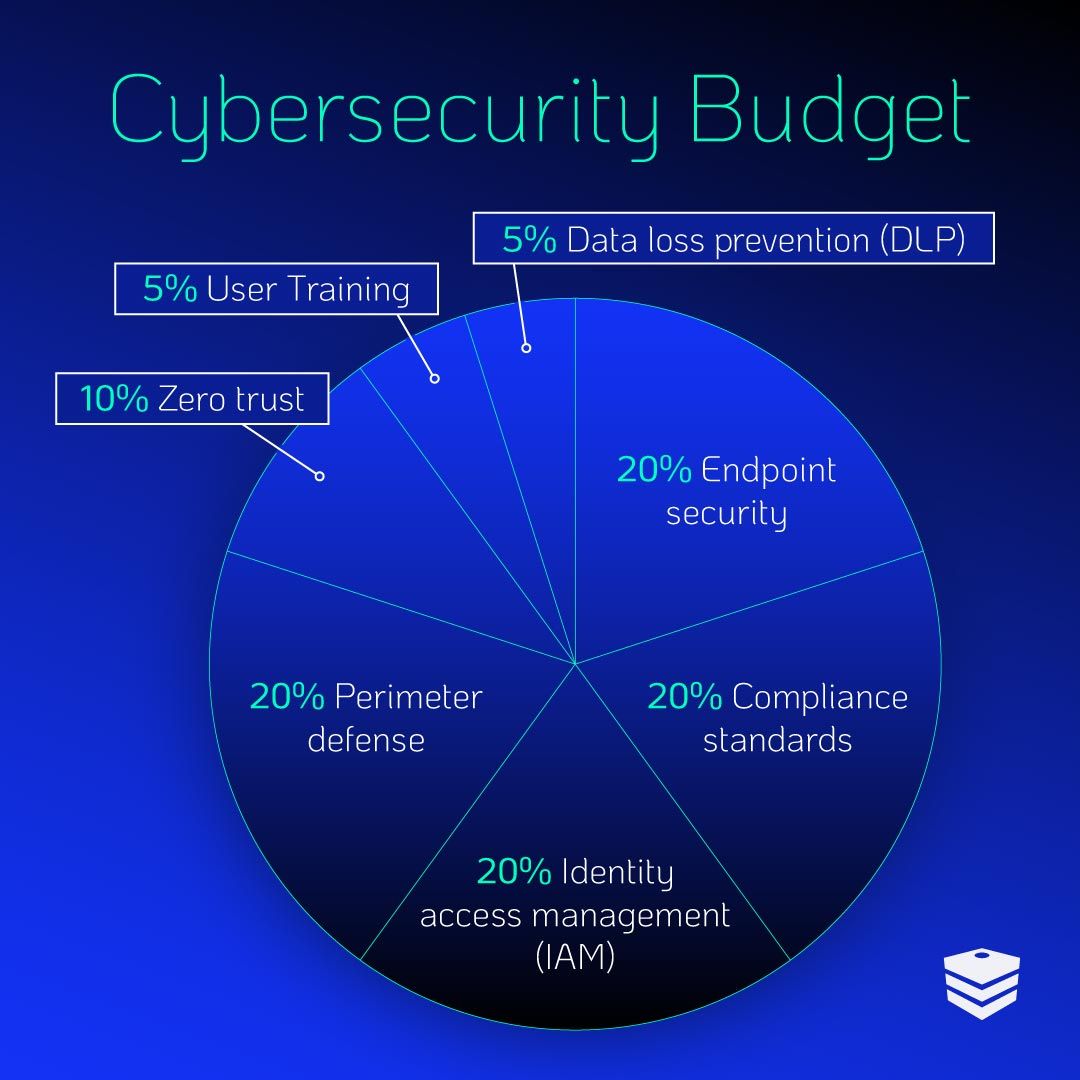Cybersecurity Consulting
How Much Do Companies Spend on Cybersecurity? | Minimize Your Losses
September 21, 2023
5 Minute Read

With the ever-changing cyber landscape and the rapid development of malicious as well as preventative tools, more businesses are adding cybersecurity to their IT budgets.
But how much should companies spend on cybersecurity?
Depending on the business size, location, and industry, a company’s cybersecurity budget can vary. For example, a healthcare company might need more regulatory compliance services than a manufacturing company. Although, with the recent rise in cybercrime, more industries are beginning to adhere to strict compliance standards.
Sign up for our newsletter!
Let’s look at how organizations are allocating their budget to properly address cybersecurity needs.
Comprehensive cybersecurity strategies require a combination of advanced technology, professional expertise, and system monitoring. Learn more about what a full-fledged cybersecurity strategy looks like in DOT Security’s Cybersecurity Checklist: How Covered Is Your Business?
Creating a Cybersecurity Budget
The rise of ransomware means that breached companies might not only have financial losses due to lost data, but also due to ransom payments, downtime, the length of negotiation, and data recovery. Here it’s important to note that DOT Security advises against negotiating with cybercriminals.
Many industries have been affected recently by ransomware, which according to the DBIR has seen a 13% increase—higher than the previous five years combined.
The rise of remote work has also put an emphasis on businesses to secure their network. While IT and cybersecurity teams are struggling to maintain resources and fill the cybersecurity talent gap, business leaders are looking for ways to safeguard their clients’, employees’, and organizations’ data.
Due to the added cost of data theft, possible ransomware, and downtime, it is imperative that businesses include cybersecurity in their budget.
The following is a suggested breakdown of how a cybersecurity budget might look.

About 985 IT leaders surveyed by the 2022 State of the CIO (Chief Information Officer) reported that they plan to invest about 15% of their IT budget into cybersecurity. Organizations investing more into cybersecurity is a trend we’ll likely see well into the future as more leaders learn about the benefits of a comprehensive cybersecurity strategy.
The Cost of a Cyberattack on a Company
Besides the actual monetary cost of a breach, organizations also have to address the costs of downtime, delayed delivery of products or services, and data recovery. This is important to consider because the cost of downtime can prove significant.
For small businesses, the cost of downtime can range between $137-$427/minute while larger enterprises see a cost that reaches $5,600-$9,000/minute. These figures demonstrate how cybersecurity attacks can financially cripple an unprepared organization.
Not only that, but it can be difficult to renew operations after a network breach and get things running normally again. However, companies that prepare for a cybersecurity emergency are better able to recover as they have a plan in place and mitigation tactics at the ready.

Global and Regional Costs
In 2022 the average cost of a data breach was $4.35 million globally, as opposed to $3.86 million in 2020. The increasing cost of a data breach paired with higher levels of awareness among business owners is contributing to the number of organizations investing in cybersecurity.
In the United States, the average organizational cost of a breach rose 244% from 2006 to 2020, according to a Statista study published in 2022. The last year tracked showed an average cost of $8.64 million.
Between compromised data, costly downtime, and reputational damage, a cybersecurity breach can essentially kill an unsecure brand in one foul swoop.

Most Affected Industries
Finance had the highest number of breaches, reaching 690 successful attacks, according to the 2022 Data Breach Investigations Report (DBIR).
Following the financial industry are public administration, manufacturing, and education. It is interesting to note that regardless of industry, smaller businesses—those with up to 1,000 employees—had more incidents as well as more confirmed breaches than larger enterprises.
The report cautions that due to different factors affecting businesses’ visibility and reporting laws, readers should not make conclusions on the security standing of certain industries. Lack of reporting does not necessarily mean a certain industry is risk-free.
The Best Alternative to a Breach
Setting up a company budget for cybersecurity and working with a managed security service provider (like DOT Security) gives businesses an easy and reliable way to cover their security and compliance needs.
Like a home security service that would protect a homeowner’s residence with surveillance and monitoring, think of a cybersecurity provider in the same way. A team of experts always looking out, monitoring, and using technology to protect your business.
As the number and variety of cyberthreats continually evolves, protecting your business assets requires a whole team of professionals who can proactively look for vulnerabilities and correct them so that you can focus on your business.
Partnering with a cybersecurity provider minimizes the need to halt operations, recover after downtime, or close a business.
Bottom Line
The average organizational cost has been rising in the United States. Costs related to a business network breach include downtime, data recovery, and reputational damage.
Businesses who partner with a cybersecurity provider minimize the chance of a successful data breach and compromised data. Even if a breach were to occur, organizations can rely on their cybersecurity provider to mitigate the damage and help them get operations up and running more quickly.
A reliable cybersecurity provider can help proactively reduce vulnerabilities, stay compliant, and devise a disaster and recovery plan. Just like a home security network, professionals work around the clock to keep your assets secure.
Securing your organization can close vulnerabilities that could lead to attacks, downtime, and loss of reputation. Ensure your company network is secure by reviewing DOT Security’s Cybersecurity Checklist: How Covered is Your Business?
